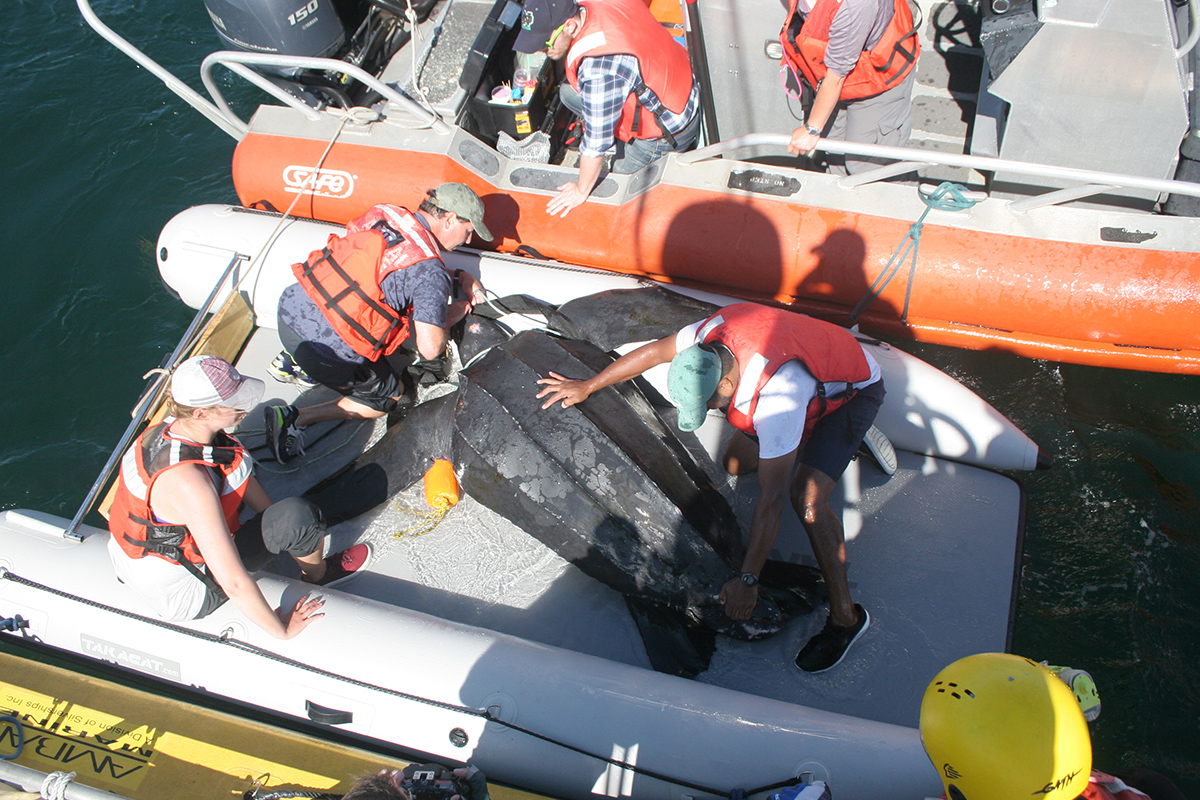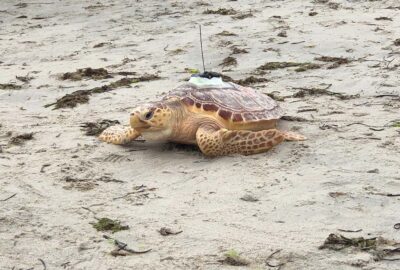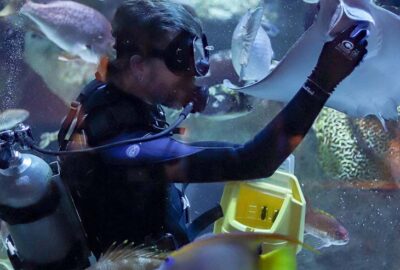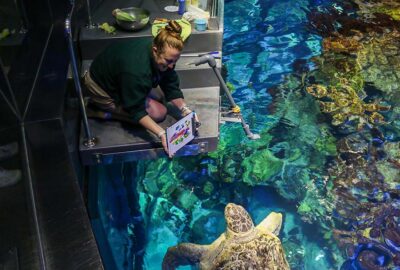Untangling Mystery
Aquarium scientists use new tagging technology to follow leatherback sea turtles freed from ensnarement
By New England Aquarium on Friday, November 20, 2020


By Daniel Ackerman
When Dr. Kara Dodge gets a call about a turtle entanglement, she snaps into go-mode. “You’re single-mindedly focused on getting your gear, getting in the car, and getting there,” says Dodge, a researcher in the Fisheries Science and Emerging Technologies (FSET) group at the New England Aquarium’s Anderson Cabot Center for Ocean Life. “So there’s a bit of a rush,” she adds, “lots of adrenaline.”
Dodge is part of a first-responder network for leatherback sea turtles that get snagged by fishing lines. She races to the scene, working with collaborators at the Center for Coastal Studies to free the turtle before it drowns or starves. Usually, the team succeeds. But what happens after they free a turtle? That remains a mystery, says Dodge. “We don’t know if these turtles then get re-entangled or if they die from their injuries.”
Dodge’s team is solving that mystery through collaboration and technology. Partnering with the Center for Coastal Studies, they’re exploring new ways to tag and track the endangered leatherbacks, revealing how the animals fare after disentanglement. “It’s really rewarding work,” says Dodge, who hopes the effort can boost leatherbacks’ prospects in the face of entanglement, one of the direst threats the turtles face in the northeast U.S.
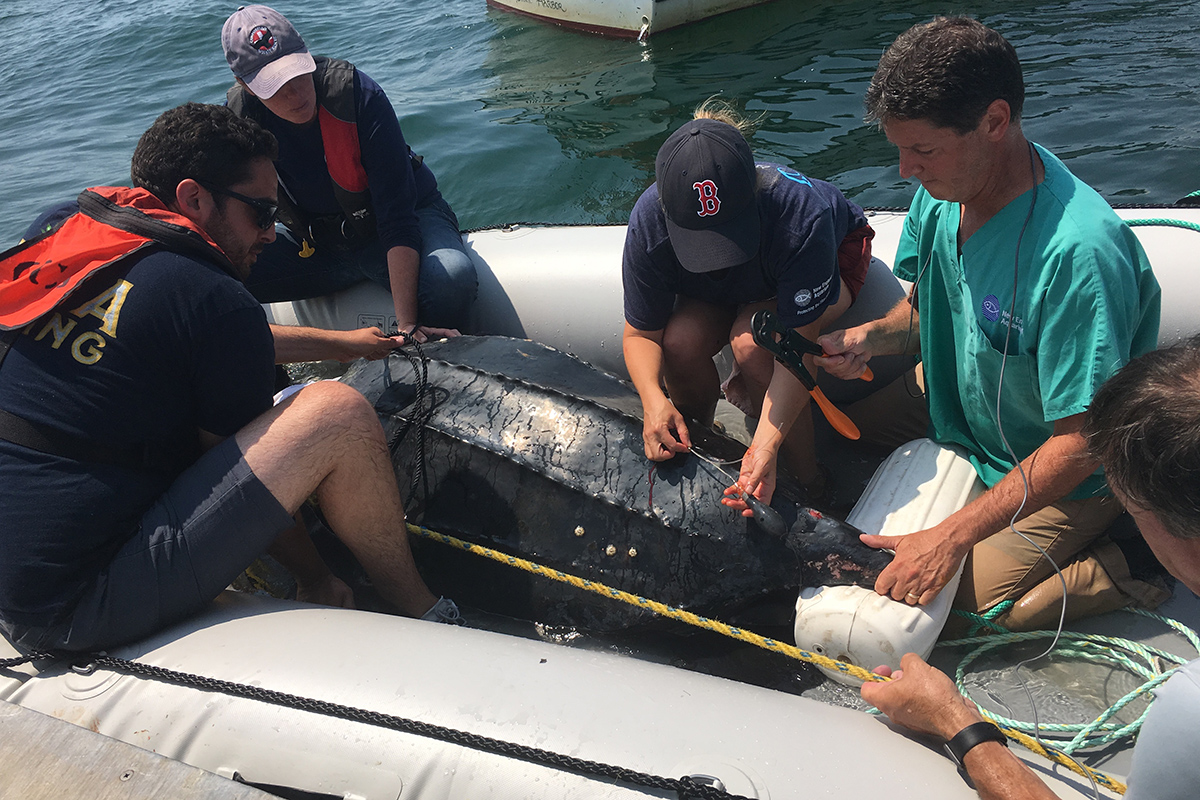
Leatherbacks spark a sense of awe in Dodge. “They’re just such a superlative species,” she says. The world’s largest sea turtles, leatherbacks can grow longer than seven feet and top out over 1,000 pounds. They’re also prolific migrators, crossing oceans and diving up to 4,000 feet below the surface. Dodge says, “Every time I work with one, I get a little chill.”
Dodge has turned her awe into action for her new project, funded by the Massachusetts Environmental Trust, which aims to uncover leatherbacks’ survival prospects after disentanglement. The first step is to learn about their behavior.
Dr. Jeff Kneebone is no stranger to tracking marine animals. More than 100 sharks and tunas roam the ocean with tags attached or implanted by Kneebone, another FSET researcher.He uses different types of tags to suit various research needs. Acoustic tags ping listening stations—“like an E-ZPass system”—to reveal when an animal passes by. Survivorship tags record thorough accounts of an animal’s activity, then they detach from the animal and float to the surface where they transmit the data via satellite. With a ten-year battery life, acoustic tags tell a long story, whereas the shorter-lived survivorship tags tell a detailed one.
Dodge and the Aquarium’s director of animal health, Dr. Charles Innis, realized these two tag types could provide a trove of information about how leatherbacks fare after entanglement—both whether they survive in the shortterm and where they travel in the longterm. The only problem: neither tag type had ever been deployed on leatherbacks before. That’s where collaboration was key.
Last summer, Kneebone worked with Dodge and Innis to overcome a range of challenges in adapting the new technology to leatherbacks. For example, they had to ensure the turtles wouldn’t shed the tags prematurely. During leatherbacks’ breeding season, “they’re banging into each other with their shells,” says Innis, “and if they bop the tag off early then we lose it.” Dodge’s team worked with Kneebone to perfect their tag attachment technique, rehearsing on the shell of a dead leatherback. “We did a bunch of practice sessions with different tagging methods to see what would work best,” says Dodge, “and Jeff [Kneebone] was definitely giving us great advice during that whole process.”
Innis adds that the collaboration was a “two-way street.” Kneebone provided turtle tagging tips, while Innis, a veterinarian, advised Kneebone on surgical equipment for his work with fishes. “There’s a lot of back-and-forth of bouncing ideas around,” says Innis. “It’s gone really well.”
So far, Dodge says the tags have done their job. Three of the four turtles they freed in 2019 survived the aftermath of their entanglement, according to data from the survivorship tags. The fourth died in a subsequent entanglement. Dodge will track the survivors with acoustic tags to learn the long-term impacts of entanglement. She hopes to find them “doing normal turtle things” like migrating toward seasonal feeding and breeding grounds.
Luckily for leatherbacks, 2020 has seen few entanglements. But Dodge stands ready to spring into action if called. She says the tagging data they generate in the coming years will help them better care for entangled leatherbacks. “I don’t see these threats going away anytime soon,” says Dodge, “but we can improve the outcomes for some of these animals.”
